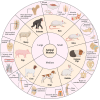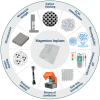Challenges and Pitfalls of Research Designs Involving Magnesium-Based Biomaterials: An Overview
- PMID: 38892430
- PMCID: PMC11172609
- DOI: 10.3390/ijms25116242
Challenges and Pitfalls of Research Designs Involving Magnesium-Based Biomaterials: An Overview
Abstract
Magnesium-based biomaterials hold remarkable promise for various clinical applications, offering advantages such as reduced stress-shielding and enhanced bone strengthening and vascular remodeling compared to traditional materials. However, ensuring the quality of preclinical research is crucial for the development of these implants. To achieve implant success, an understanding of the cellular responses post-implantation, proper model selection, and good study design are crucial. There are several challenges to reaching a safe and effective translation of laboratory findings into clinical practice. The utilization of Mg-based biomedical devices eliminates the need for biomaterial removal surgery post-healing and mitigates adverse effects associated with permanent biomaterial implantation. However, the high corrosion rate of Mg-based implants poses challenges such as unexpected degradation, structural failure, hydrogen evolution, alkalization, and cytotoxicity. The biocompatibility and degradability of materials based on magnesium have been studied by many researchers in vitro; however, evaluations addressing the impact of the material in vivo still need to be improved. Several animal models, including rats, rabbits, dogs, and pigs, have been explored to assess the potential of magnesium-based materials. Moreover, strategies such as alloying and coating have been identified to enhance the degradation rate of magnesium-based materials in vivo to transform these challenges into opportunities. This review aims to explore the utilization of Mg implants across various biomedical applications within cellular (in vitro) and animal (in vivo) models.
Keywords: animal model; biomaterial; implant; in vitro; magnesium.
Conflict of interest statement
Alexander Kopp is employee of Meotec GmbH. The authors declare no conflicts of interest.
Figures





Similar articles
-
Biodegradable magnesium-based biomaterials: An overview of challenges and opportunities.MedComm (2020). 2021 Apr 8;2(2):123-144. doi: 10.1002/mco2.59. eCollection 2021 Jun. MedComm (2020). 2021. PMID: 34766139 Free PMC article. Review.
-
In vitro biodegradation behavior of magnesium and magnesium alloy.J Biomed Mater Res B Appl Biomater. 2011 Aug;98(2):203-9. doi: 10.1002/jbm.b.31769. J Biomed Mater Res B Appl Biomater. 2011. PMID: 21732527
-
Current status and perspectives of zinc-based absorbable alloys for biomedical applications.Acta Biomater. 2019 Oct 1;97:1-22. doi: 10.1016/j.actbio.2019.07.034. Epub 2019 Jul 24. Acta Biomater. 2019. PMID: 31351253 Review.
-
Degradable magnesium-based alloys for biomedical applications: The role of critical alloying elements.J Biomater Appl. 2019 May;33(10):1348-1372. doi: 10.1177/0885328219834656. Epub 2019 Mar 9. J Biomater Appl. 2019. PMID: 30854910 Review.
-
Magnesium biomaterials for orthopedic application: a review from a biological perspective.J Biomed Mater Res B Appl Biomater. 2014 Aug;102(6):1316-31. doi: 10.1002/jbm.b.33113. Epub 2014 Jan 24. J Biomed Mater Res B Appl Biomater. 2014. PMID: 24458999 Review.
Cited by
-
Organoids for tissue repair and regeneration.Mater Today Bio. 2025 Jun 23;33:102013. doi: 10.1016/j.mtbio.2025.102013. eCollection 2025 Aug. Mater Today Bio. 2025. PMID: 40621183 Free PMC article. Review.
References
-
- Fu Q., Liang W., Huang J., Jin W., Guo B., Li P., Xu S., Chu P.K., Yu Z. Research perspective and prospective of additive manufacturing of biodegradable magnesium-based materials. J. Magnes. Alloys. 2023;11:1485–1504. doi: 10.1016/j.jma.2023.05.002. - DOI
-
- Thomas K.K., Zafar M.N., Pitt W.G., Husseini G.A. Biodegradable Magnesium Alloys for Biomedical Implants: Properties, Challenges, and Surface Modifications with a Focus on Orthopedic Fixation Repair. Appl. Sci. 2024;14:10. doi: 10.3390/app14010010. - DOI
Publication types
MeSH terms
Substances
Grants and funding
LinkOut - more resources
Full Text Sources

